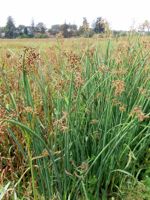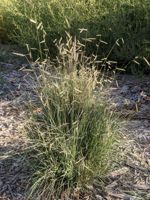Mon-Fri 9am - 5pm Mountain time
Softstem Bulrush vs Blue Grama Grass
Schoenoplectus tabernaemontani
Bouteloua gracilis
CUSTOM GROW
NOT AVAILABLE THIS SEASON - MIGHT RETURN
Softstem Bulrush is a native perennial sedge that forms dense colonies of tall, upright stems. Thriving in saturated soils and shallow water, it spreads vigorously by rhizomes, creating large colonies that stabilize shorelines, control erosion, and strengthen wetland ecosystems.
Dense stands of Softstem Bulrush create shelter and nesting sites for birds, while also supporting aquatic invertebrates and the larvae of numerous insects. It is also an important food source. Many wetland birds, especially ducks, feed on the seeds, while muskrats feed on the foliage and rhizomes. Well-suited for ecological restoration, waterside & riparian plantings, erosion control, and habitat enhancement projects.
Blue Grama is a native perennial bunchgrass recognized for its blue-green blades and unique seed heads. They grow along one side of the stem and are often compared to eyelashes, eyebrows, or mosquito larvae, which inspired its common names, Eyelash Grass and Mosquito Grass. As the seed heads begin to dry in the fall, they curl, further enhancing the plant’s distinctive appearance. The seeds provide food for birds, and the grass serves as a host plant for certain species of skipper butterflies.
As a warm-season grass, Blue Grama has a slow start in spring and does not actively grow until soil temperatures rise. Its deep roots help with erosion control, and the grass is drought-tolerant once established, thriving even in poor or alkaline soils. It is well-suited for soil stabilization, naturalization, restoration projects, or as an ornamental accent in gardens and landscapes.

